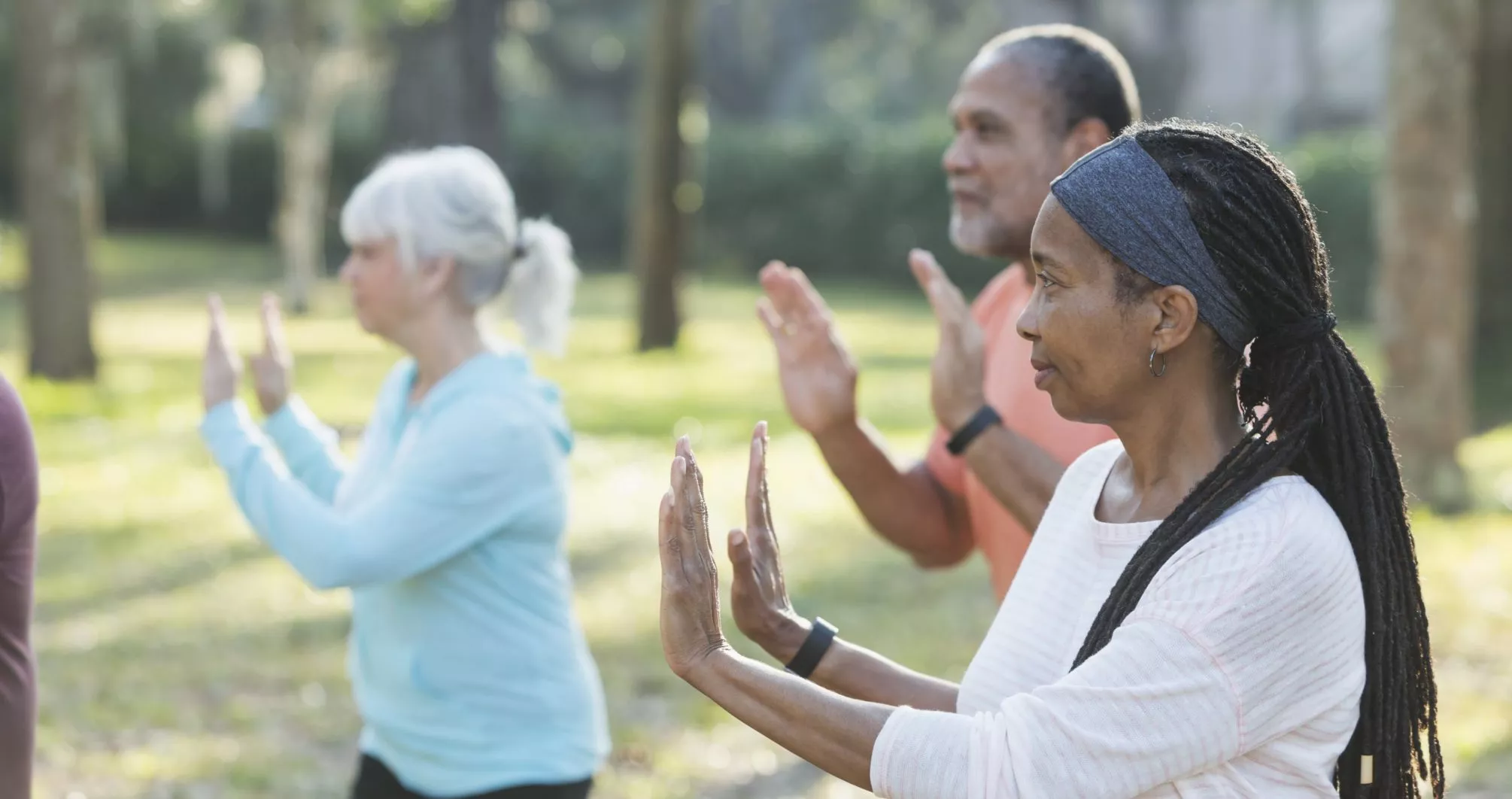Chances are you have seen seniors doing tai chi at the park. Their faces serene, their bodies poised and relaxed as they shifted their weight from one foot to another.
Maybe your interest was piqued and you asked yourself what was the appeal. Tai Chi is often called “meditation in motion” because it is one of the best forms of calming, therapeutic exercises whereby you can both meditate and move mindfully at the same time.
What is tai chi?
Tai Chi is an ancient Chinese form of physical exercise that was originally used to train warriors for self-defense, but is now used by seniors worldwide to gently stretch and exercise the body. Originating from Taoism, tai chi was practiced by the Chinese so chi, or life force, could flow through their bodies. That meant they could enjoy greater health, vibrancy, and balance in life.
Popular because of its meditative effects and its use of standing without any harsh impact to the knees, tai chi has many benefits. One Harvard Study espoused the benefits of tai chi so greatly that they referred to it as “medication in motion,” citing the growing evidence of how the mind-body nature of tai chi lends itself to increased health, peace, and longer lifespan.
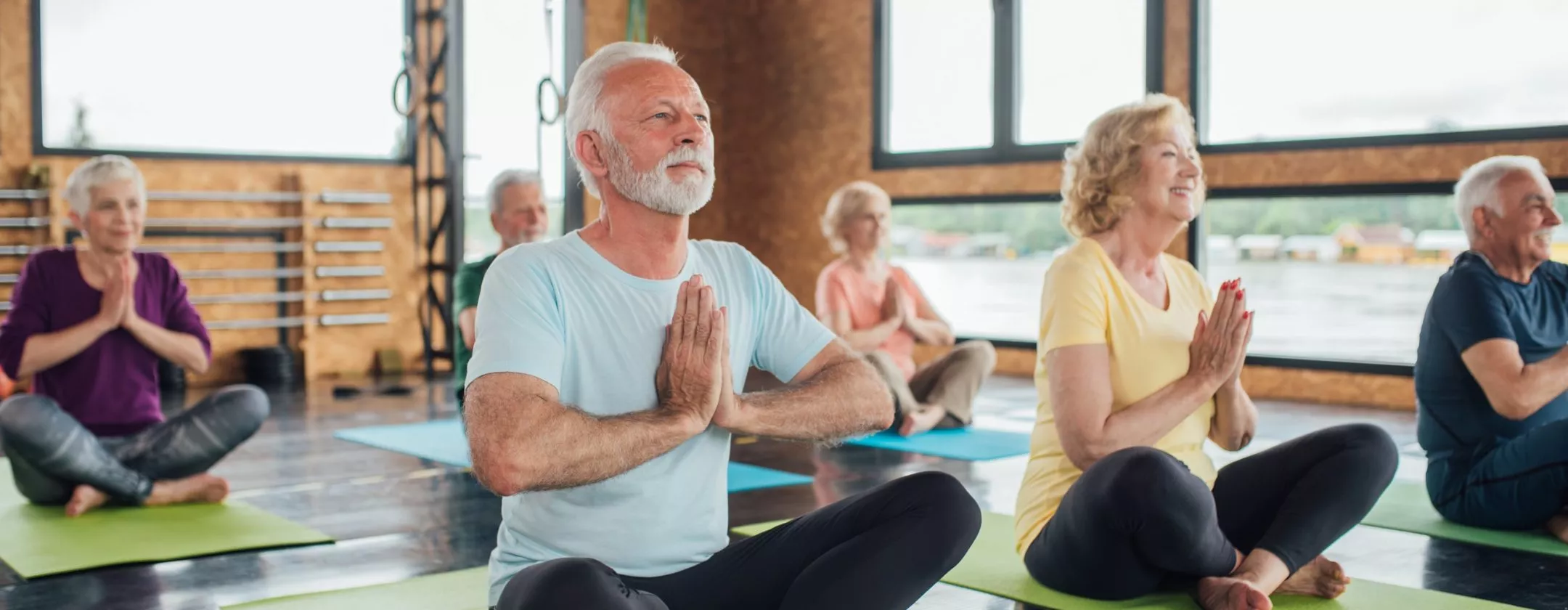
Photo Courtesy of RgStudio/iStock
Who is tai chi for?
Tai chi is beneficial for many seniors, but especially for seniors who are living with arthritis pain, seniors confined to wheelchairs, or seniors recovering from surgery or a fall. There is no jumping–rather, tai chi consists of a series of movements where one pose flows into the next. This means that the exercise is low-impact to the knees, which is helpful to seniors who are living with knee pain or seniors who do not like high-intensity exercises. Tai chi can be adapted to fit the needs of people in wheelchairs with chair tai chi. Tai chi has many health benefits, such as mental clarity and bodily awareness, and it is a safe and restorative form of exercise that has been enjoyed through the centuries. Of course, before starting any exercise program, one should always consult your physician to confirm that it is safe for you.
Where can I learn tai chi?
Tai chi is easy to follow with the help of an in-person instructor at a tai chi class or online instruction through tai chi DVDs and Youtube videos. You can find affordable tai chi classes through your local Chinese American Association or through community organizations such as the local YMCA or city community classes.
The great news about tai chi is that it requires no equipment and seniors can practice it anywhere–at the park or at home. Wear loose clothing, comfortable tennis shoes, and do some gentle warm-up stretching before getting started.
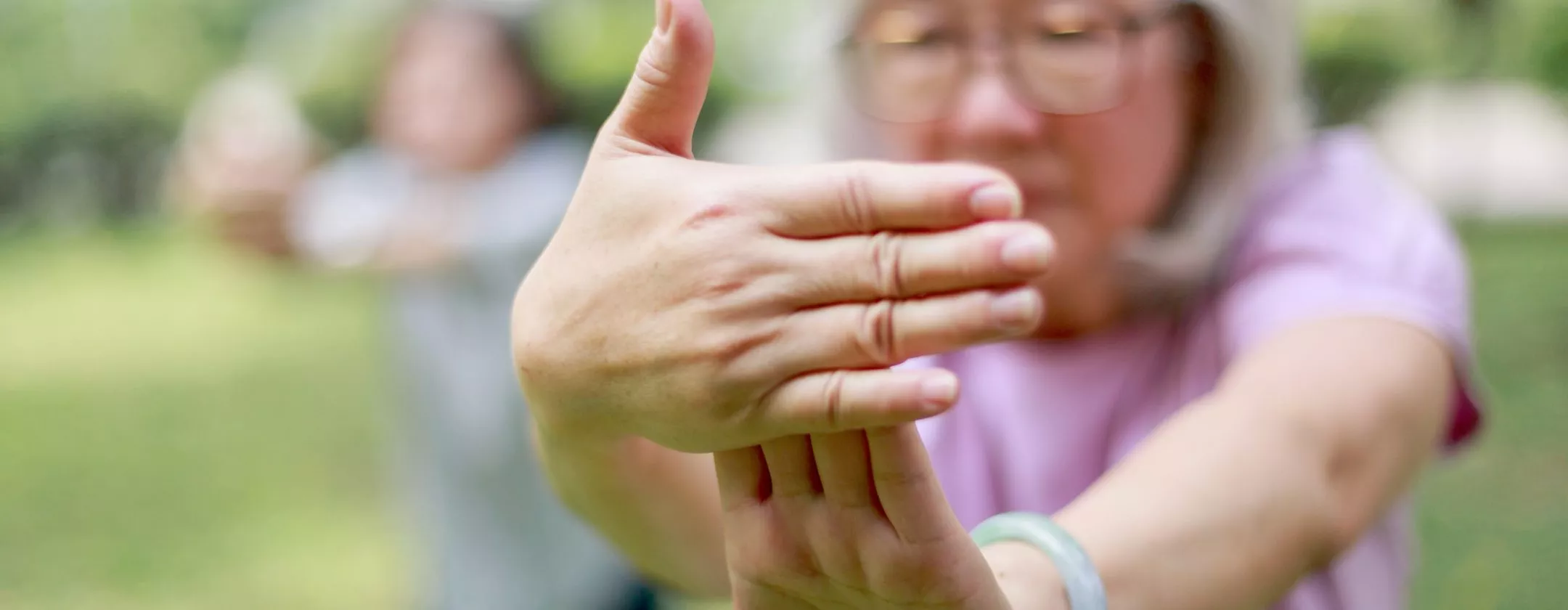
Photo Courtesy of hoodesigns/iStock
What are the benefits of tai chi?
Balance, grace, and posture are all paramount in tai chi. It’s common for seniors who consistently practice tai chi to “improve [their] balance, stability, and flexibility” and enjoy “reduced pain, especially from knee osteoarthritis, back problems, and fibromyalgia” (widespread muscle pain) according to Healthline. The benefits of tai chi are many:
-
Tai chi helps reduce stress
Tai chi reduces stress as seniors breathe in tandem with their flowing movement. They enjoy inhaling large amounts of oxygen, cushioning their joints, improving circulation, and lowering their blood pressure. One study from the National Library of Medicine found that practicing tai chi reduced depression and anxiety. Instead of worrying about the daily concerns of their day, seniors must focus on balance and imbue each movement with energy. Seniors also focus on unique nature-based imagery such as “ride the tiger to the mountain” or “lift the mountain” which can help them focus on the serenity of life. Seniors must also take deep, deliberate breaths aligned to the gentle, flowing movements. The combination of deep breathing along with slow, mindful movements makes tai chi a great way to release stress.
-
Tai chi improves balance and prevents falls
“There are about 36 million falls reported among older adults each year” according to the Center for Disease Control. Falls are dangerous because they can result in broken bones, head injuries, hip fractures, hospitalizations, and even deaths. The lack of mobility and joint pain that seniors experience cause them to fear falling and be extremely careful about movement. This impedes quality of life. Tai chi can help seniors to feel confident about moving.
Tai chi strengthens muscles in the legs and improves core strength. A study from Emory University showed that tai chi classes can help reduce the risk of falls by almost 50%. At a tai chi class, you will find yourself flexing your knees and shifting your weight deliberately and mindfully from one foot to the other, building your confidence. By being cognizant of everything from your posture to where your foot will land next, seniors can learn to be more mindful, balanced, and secure in their footing.
-
Tai chi helps promote mind-body awareness and health.
Tai chi helps seniors to concentrate and enjoy increased bodily awareness. Seniors will focus on their bodily sensations and improve their mind-body spatial awareness. Knowing how to coordinate your mind and body is so important for activities such as dance, singing, playing the piano, gardening, and many other activities that make life joyful. Tai chi strengthens the leg muscles and helps seniors to enjoy moving their body in new, fluid ways without impacting their knees. Tai chi has been proven to alleviate arthritis pain according to a study from Tufts Medical Center, and studies from the Sleep Foundation even say that tai chi helps boost immunity and provides better sleep. Tai chi strengthens the body and the mind, helping seniors to move fluidly and enjoy an enhanced quality of life.
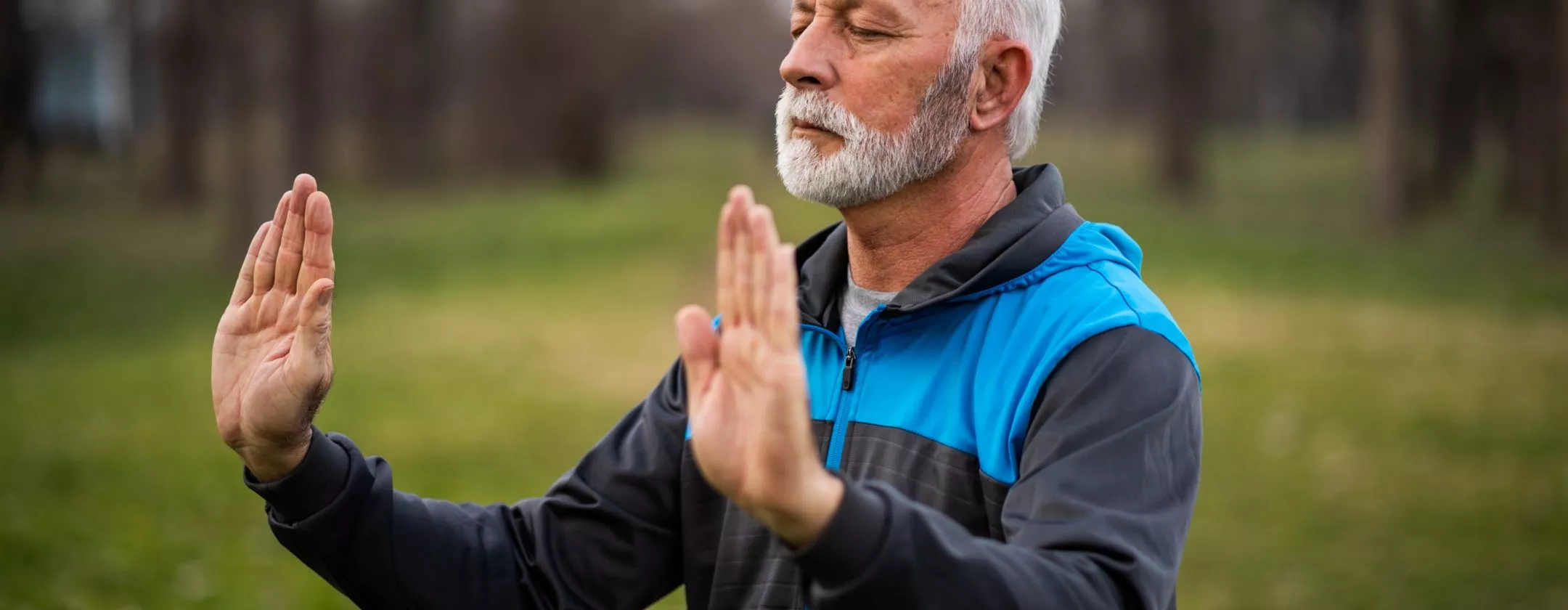
Photo Courtesy of Photodjo/iStock
What are some tai chi exercises? Here are some Youtube instructional videos we recommend.
- This 10-minute video seated tai chi video is created especially for seniors. Great for beginners and created by a renowned tai chi expert, David Dorian-Ross.
- If you want to keep growing your tai chi practice, use this 20 minute seated tai chi video by David Dorian-Ross.
- This 20 minute daily tai chi for Beginners and Seniors video by Don Fiore is energizing and peaceful.
- If you’re new to tai chi, then Freshfield Fitness’s 10 minute tai chi at home video for seniors is a great way to get started.
- Cara Kircher’s gentle 25-minute tai chi video shows a routine developed by therapists in Toronto’s LEAP Service (Living Engaged and Actively with Pain). We love the outdoor scenery!
A movement practice related to tai chi is qigong. One of the most popular qigong exercises is called ‘Eight Brocades.’ They are a set of sequential stretches that have been practiced for thousands of years to improve health and well-being. Each stretch corresponds to a different meridian, or channel through which chi flows.
8-Brocade Exercises
- Pressing Up the Heavens
- Drawing the Bow
- Separating Heaven and Earth
- Wise Owl Gazes Backward
- Shake the Head & Swing the Tail
- Punch with Angry Eyes
- Press the Earth, Shake the Sky
- Lifting up the Heels
Follow the steps of this helpful Youtube video.
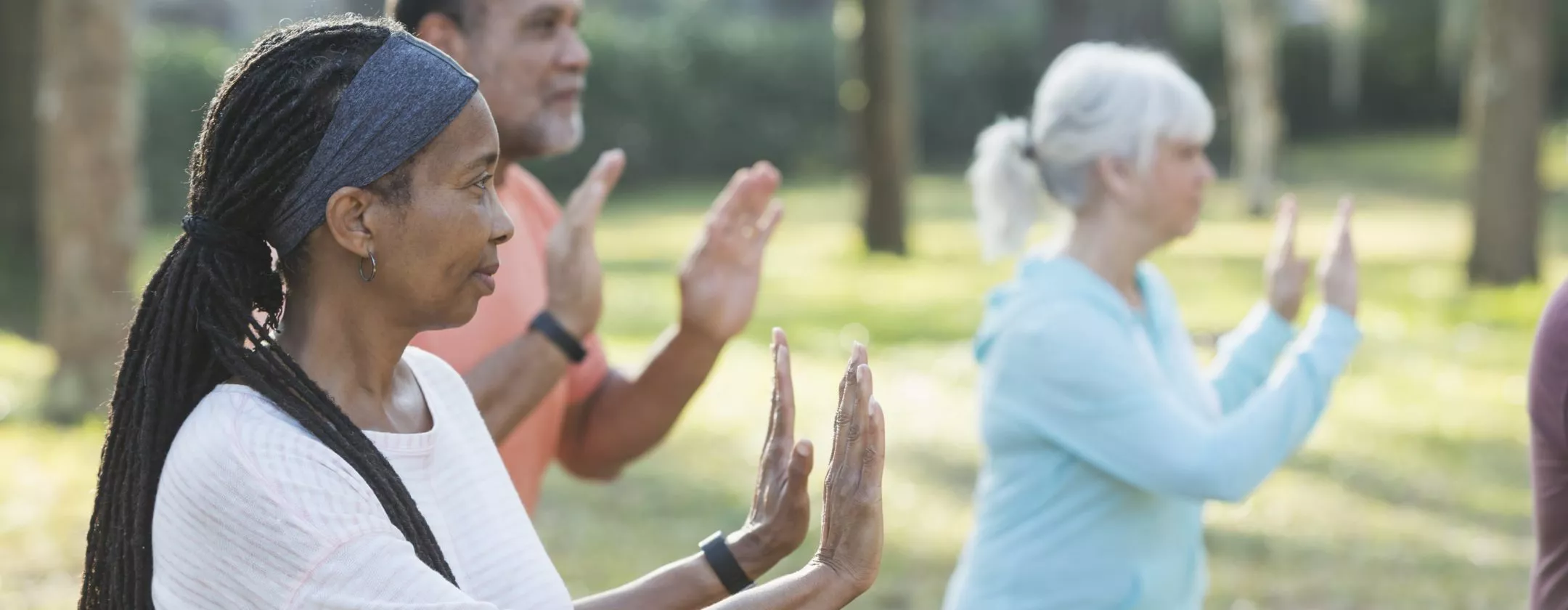
Photo Courtesy of kali9/iStock
Here at Oakmont, we love doing tai chi along with other movement programs. We’re devoted to providing the best exercise classes, sports, and games to build our residents’ strength, balance, flexibility, and endurance. Residents love our dedicated fitness center and walking club! To find out more about the programs we offer and how you can join the fun, please contact us.
